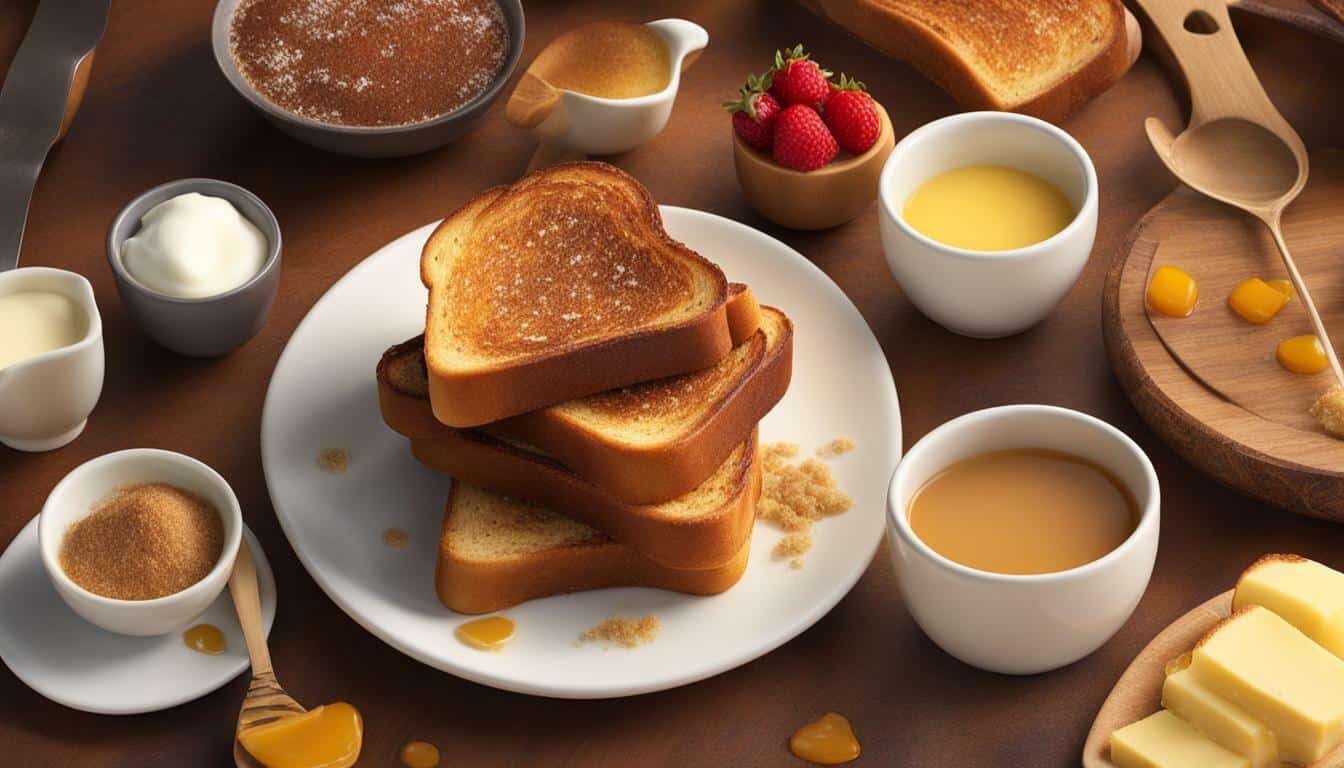French toast is a popular breakfast dish loved by many, but have you ever wondered about its carbohydrate content and how it can affect your blood sugar? Managing blood sugar levels is crucial for individuals with diabetes, and understanding the carb count of the foods we consume is an important part of this process. In this deep-dive, we will explore the world of French toast, uncover its nutritional facts, and discover tips to make it more diabetes-friendly.
- French toast can be enjoyed without compromising blood sugar control through proper planning and attention.
- The carbohydrate content of French toast varies based on factors such as the type of bread and toppings used.
- It is important to pre-bolus with insulin before consuming French toast to manage blood sugar spikes.
- Paying attention to the fat and protein content in French toast can help with managing carb intake.
- Being mindful of the carb count and potential impact of fat and protein can allow for the enjoyment of delicious French toast while still maintaining a balanced diet.
French Toast and Diabetes: Finding a Balance
For individuals with diabetes, French toast may seem like a forbidden indulgence, but with a few tweaks, it can still be enjoyed as part of a balanced diet. Managing blood sugar levels is crucial, and understanding the carbohydrate content of your French toast is essential in achieving that balance.
When it comes to French toast, the type of bread and toppings used can significantly impact the carbohydrate count. For a lower-carb option, consider using whole grain bread or low-carb alternatives like almond flour bread. These options provide a higher fiber content, which can help slow down the absorption of carbohydrates, preventing sudden blood sugar spikes.
It’s also important to be mindful of the toppings you choose. Instead of syrup, opt for sugar-free alternatives or fresh berries, which add natural sweetness without the added sugars. Fresh fruit can also provide additional fiber and essential nutrients.
Sample Table: Carbohydrate Content of Common French Toast Ingredients
| Ingredient | Carbohydrate Content per Serving (g) |
|---|---|
| White bread (2 slices) | 30 |
| Whole wheat bread (2 slices) | 20 |
| Almond flour bread (2 slices) | 10 |
| Sugar-free syrup (2 tbsp) | 0 |
| Fresh berries (1/2 cup) | 6 |
Remember, portion control is key. Opt for smaller serving sizes to keep your carbohydrate intake in check. Pairing your French toast with a source of protein, such as eggs or lean turkey bacon, can also help slow down the digestion of carbohydrates and provide a more balanced meal.
By making mindful choices and monitoring your blood sugar levels, you can enjoy French toast without compromising your diabetes management goals.

- Choose lower-carb bread options like whole grain or almond flour bread.
- Select sugar-free or fresh fruit toppings instead of traditional syrup.
- Monitor portion sizes and incorporate protein to slow down carbohydrate digestion.
- Ensure you check your blood sugar levels before and after consuming French toast.
Uncovering French Toast Nutrition: What You Need to Know
Let’s delve into the nutritional aspects of French toast, from its calorie content to the vitamins and minerals it provides. French toast is a popular breakfast option that combines slices of bread soaked in a mixture of eggs and milk, then cooked to a golden brown perfection. While it is undeniably delicious, it’s important to be aware of its nutritional composition, especially if you’re watching your calorie intake or looking for a low-calorie alternative.
On average, a slice of French toast made with regular bread contains approximately 150-200 calories. The exact calorie count can vary depending on the type and thickness of the bread, as well as the amount of butter or oil used for cooking. If you’re looking to reduce the calorie content, opting for whole wheat or multigrain bread can be a healthier choice. These types of bread are generally higher in fiber and nutrients compared to white bread, providing a more well-rounded nutritional profile.
In addition to calories, French toast also offers some essential nutrients. The eggs used in the batter are a good source of protein, providing a boost to help keep you fuller for longer. They also contain important vitamins such as vitamin A, vitamin D, and vitamin B12. Meanwhile, the milk used in the soaking mixture contributes calcium, which is essential for maintaining strong bones and teeth. Adding a sprinkle of cinnamon to your French toast not only enhances the flavor but also provides antioxidants that can help reduce inflammation in the body.
French Toast Nutrition Facts Table:
| Nutrient | Amount per serving |
|---|---|
| Calories | 150-200 |
| Protein | 6-8 grams |
| Carbohydrates | 20-25 grams |
| Fat | 6-10 grams |
| Calcium | 100-150 mg |
| Vitamin A | 100-150 IU |
| Vitamin D | 40-60 IU |
| Vitamin B12 | 0.3-0.5 mcg |
While French toast can be a tasty and satisfying breakfast option, it’s important to be mindful of portion sizes and the additional toppings or syrups you choose to accompany it. Opting for fresh fruits, such as berries, instead of sugary syrups can provide added nutrients without significantly increasing the calorie count. Remember, moderation is key when it comes to enjoying French toast as part of a balanced diet.
Choosing the Right Bread for Healthy French Toast
The type of bread you choose for your French toast can make a significant difference in both taste and healthiness. When aiming for a healthier option, consider opting for gluten-free bread, which is made from alternative flours such as almond flour or coconut flour. Not only does this type of bread help individuals with gluten sensitivities or celiac disease, but it also tends to be lower in carbohydrates compared to traditional bread.
Gluten-free bread options often have a lower glycemic index, meaning that they have a lesser impact on blood sugar levels. This is particularly important for individuals with diabetes or those looking to manage their carbohydrate intake. Additionally, gluten-free bread can have a nuttier and denser texture, adding a unique flavor to your French toast.
One popular gluten-free bread option for French toast is made from sprouted grains. Sprouted grain bread is created by sprouting the grains before they are ground into flour, which makes it easier to digest and increases the availability of nutrients. This type of bread is packed with fiber, protein, and essential vitamins and minerals, making it a nutritious choice for a satisfying French toast experience.
Choosing the Right Gluten-Free Bread:
| Bread Option | Carbohydrate Content per Slice | Taste and Texture |
|---|---|---|
| Almond Flour Bread | 12g | Moist and slightly nutty |
| Coconut Flour Bread | 8g | Dense and cake-like |
| Sprouted Grain Bread | 15g | Nutty and hearty |
Experimenting with different gluten-free bread options can help you find the perfect choice for your taste preferences and dietary needs. Whether you prefer a bread made from almond flour, coconut flour, or sprouted grains, selecting the right bread can enhance the overall healthiness of your French toast while maintaining its deliciousness.
Keto French Toast: A Low-Carb Delight
If you’re following a keto diet and craving French toast, fear not! There are ways to enjoy this breakfast favorite while staying in ketosis. By making a few simple substitutions and getting creative with your ingredients, you can indulge in a delicious and low-carb version of this classic dish.
Instead of using traditional bread, which is typically high in carbs, opt for keto-friendly alternatives such as almond flour bread or coconut flour bread. These breads are lower in carbohydrates and higher in healthy fats, making them a perfect fit for a keto diet.
To add a touch of sweetness without using refined sugars, you can use natural sugar substitutes like stevia or erythritol. These alternatives provide the sweetness you crave without the extra carbs. And for that classic French toast flavor, don’t forget to add a pinch of cinnamon and a splash of vanilla extract.
When it comes to toppings, opt for keto-friendly options such as sugar-free maple syrup, fresh berries, or a dollop of whipped cream. These toppings will add flavor and texture without derailing your keto goals.

By being mindful of your ingredient choices and making a few tweaks to the traditional recipe, you can enjoy a delicious plate of French toast without sacrificing your ketogenic lifestyle.
Boosting Protein with High Protein French Toast
Looking to add an extra protein punch to your French toast? Discover how you can turn this classic dish into a high-protein breakfast. By incorporating protein-rich ingredients, you can transform your French toast into a more nutritious and satisfying meal.
One way to boost the protein content of your French toast is by using protein bread. This type of bread is specially formulated to have a higher protein content compared to regular bread. Look for options made with whole grains and fortified with protein sources like whey or soy. Not only will this add more protein to your French toast, but it will also provide additional nutrients and fiber.
Another great way to increase protein is by adding a protein powder to your French toast batter. Choose a high-quality protein powder that suits your dietary needs and preferences. Simply mix the powder with the egg mixture before soaking the bread. This simple addition can significantly increase the protein content of your French toast.
High Protein French Toast Recipe
Try out this delicious high protein French toast recipe:
| Ingredients | Instructions |
|---|---|
| 2 slices of protein bread | 1. In a shallow bowl, whisk together 2 eggs, 1 scoop of your favorite protein powder, and a splash of unsweetened almond milk. 2. Heat a non-stick skillet over medium heat and coat it with cooking spray or a small amount of oil. 3. Dip each slice of protein bread into the egg mixture, making sure it’s coated on both sides. 4. Place the coated bread slices onto the skillet and cook for 2-3 minutes on each side, or until golden brown. 5. Serve the high protein French toast with a drizzle of sugar-free syrup and a sprinkle of cinnamon. |
With this simple recipe, you can enjoy a delicious and protein-packed French toast breakfast. Feel free to experiment with different toppings and flavors to suit your taste preferences. Remember to adjust the portion size and toppings to manage your overall carbohydrate intake if you’re watching your blood sugar levels.

Incorporating protein into your French toast not only adds a nutritional boost but also helps to keep you feeling fuller for longer. Enjoy this protein-packed twist on a breakfast favorite and fuel your day with a satisfying meal that supports your health and wellness goals.
Decadence without Guilt: Sugar-Free French Toast
Indulge in the sweet flavors of French toast without worrying about the sugar content with these sugar-free options. For those looking to satisfy their cravings while keeping their blood sugar levels in check, there are a variety of delicious alternatives to traditional French toast recipes that are free from added sugars.
One option is to use sugar-free bread or low-carb bread to reduce the overall carbohydrate content of your French toast. There are many brands available that offer bread specifically designed for individuals who want to limit their sugar intake. These bread options can be just as tasty as regular bread but without the added sugar.
Another way to enjoy sugar-free French toast is to experiment with alternative sweeteners such as stevia or monk fruit. These natural sweeteners provide a sweet taste without the blood sugar spikes associated with traditional sugars. You can easily incorporate these sweeteners into your French toast batter or drizzle them on top as a syrup substitute.

To add even more flavor to your sugar-free French toast, try incorporating spices such as cinnamon or nutmeg. These spices not only enhance the taste but also provide additional health benefits. Cinnamon, for example, has been shown to help regulate blood sugar levels.
By making a few simple swaps and being mindful of the ingredients you use, you can enjoy the decadence of French toast without the guilt of added sugar. So go ahead, satisfy your cravings, and start your day off right with a delicious and sugar-free French toast breakfast!
Toppings and Extras: Finding the Right Balance
While the core ingredients of French toast may have a significant impact on carb content, it’s important not to overlook the impact of toppings and extras. These additional elements can add flavor and texture to your French toast, but they can also increase the overall carbohydrate count. To strike the right balance between indulgence and managing your carb intake, here are some tips for selecting toppings and extras:
- Opt for fresh fruits: Instead of sugary syrup, consider topping your French toast with fresh berries or sliced fruits. Not only do they add natural sweetness, but they also provide essential vitamins and minerals.
- Choose sugar-free alternatives: If you prefer a sweeter taste, look for sugar-free syrup options or use natural sweeteners like stevia or monk fruit. These alternatives can help reduce the overall sugar content of your French toast.
- Experiment with spices: Sprinkle some cinnamon or nutmeg on top of your French toast for an extra burst of flavor. These spices not only add a delightful aroma but also offer potential health benefits, such as improving insulin sensitivity.
- Get creative with spreads: Instead of butter, consider using nut butter or avocado as a healthier spread option. These alternatives provide healthy fats and additional nutrients.
“The right combination of toppings and extras can transform your French toast from a simple breakfast dish to a delightful culinary experience.”
Remember, moderation is key when it comes to toppings and extras. It’s not necessary to completely eliminate them, but be mindful of the quantity and nutritional impact. By making conscious choices and finding the right balance, you can enjoy your French toast while still managing your carbohydrate intake.
| Toppings | Carbohydrate Content (per serving) |
|---|---|
| Sliced Strawberries | 6g |
| Blueberry Compote | 12g |
| Sugar-Free Maple Syrup | 2g |
| Cinnamon | 0g |
| Nut Butter | 4g |
| Avocado | 2g |

As you can see, there are plenty of options to elevate your French toast experience without adding excessive carbs. Whether you prefer a fruity twist, a touch of spice, or a creamy spread, there’s a wide range of toppings and extras to suit your taste preferences and dietary needs. Enjoy your French toast mindfully, and savor every delicious bite!
Managing Blood Sugar with French Toast
If you have diabetes, it’s crucial to have a clear plan in place to manage your blood sugar when indulging in French toast. With a few adjustments and mindful choices, you can enjoy this breakfast favorite without causing significant spikes in your blood glucose levels.
One key aspect to consider is the carbohydrate content of French toast. The type of bread you use can greatly impact the amount of carbs in each serving. For example, brioche bread, which is commonly used for French toast, tends to have more carbohydrates per slice compared to regular bread. To keep your blood sugar stable, consider opting for whole grain or low-carb bread options instead.
Next, pay attention to the toppings and fillings you choose. While they may add delicious flavor, certain toppings can significantly increase the overall carbohydrate count. For instance, caramel, berries, and sweet syrups can all contribute to blood sugar spikes. Rather than drenching your French toast in sugary toppings, opt for lower-carb alternatives like sugar-free syrup or fresh fruit.
| Toppings | Carbohydrate Content (per serving) |
|---|---|
| Caramel Sauce | 15g |
| Maple Syrup | 12g |
| Fresh Berries | 10g |
| Sugar-Free Syrup | 2g |
Finally, considering the overall composition of your meal can also impact blood sugar control. Incorporating fat and protein can help slow down the absorption of carbohydrates, preventing rapid spikes. French toast contains eggs, which provide both fat and protein. Additionally, adding a dollop of whipped cream or a sprinkle of nuts can further enhance the nutritional profile of your French toast and help stabilize blood sugar levels.

By being mindful of the carbohydrate content, choosing appropriate toppings, and considering the composition of your meal, you can enjoy French toast while managing your blood sugar effectively. Remember to monitor your blood glucose levels and work closely with a healthcare professional to develop a personalized plan that works best for you.
The Importance of Portion Control and Moderation
Enjoying French toast is all about finding the right balance and being mindful of portion sizes for a healthy and satisfying meal. While it’s tempting to indulge in a large stack of French toast, it’s important to remember that portion control plays a crucial role in managing blood sugar levels and overall health.
When it comes to portion sizes, it’s best to aim for moderation. Limiting the number of slices of French toast can help reduce the overall carbohydrate intake. It’s advisable to opt for smaller slices or even share a serving with a friend or family member. By doing so, you can still enjoy the delicious flavors while keeping your blood sugar in check.
Another strategy to maintain portion control is to focus on incorporating other elements into your meal. Including a source of protein, such as eggs or Greek yogurt, can help increase satiety and slow down the absorption of carbohydrates. Adding a side of fresh fruits or vegetables can also provide additional nutrients and fiber, making your meal more balanced and satisfying.
Remember, portion control doesn’t mean depriving yourself of the foods you love. It simply means being mindful of your choices and listening to your body’s hunger and fullness cues. Enjoying French toast in moderation can still be a delightful part of a healthy and well-rounded diet.

Creating a table to illustrate the carbohydrate content of different types of bread used for French toast can be helpful in making informed choices. Below is an example:
| Bread Type | Carbohydrates per Slice (approximately) |
|---|---|
| White bread | 15 grams |
| Whole wheat bread | 18 grams |
| Brioche bread | 25 grams |
| Gluten-free bread | 20 grams |
By choosing bread with a lower carbohydrate content or opting for gluten-free alternatives, you can enjoy your French toast while managing your carb intake more effectively.
Conclusion
French toast can be a delicious and satisfying breakfast option, as long as you approach it with mindfulness and awareness of your dietary needs. For individuals with diabetes, managing blood sugar levels is crucial when enjoying this classic dish. By pre-bolusing with insulin and carefully selecting the right bread and toppings, you can still indulge in French toast without compromising your blood sugar control.
The carbohydrate content of French toast can vary depending on factors such as the type of bread and additional toppings used. Brioche bread, often used for French toast, tends to have more carbohydrates per slice compared to regular bread. Cream cheese frosting and stuffing in stuffed French toast can also contribute to the overall carbohydrate count. Toppings like caramel, berries, and syrup can further increase the carb content. To manage your carb intake, consider sharing the dish or paying attention to the fat and protein content.
French toast contains eggs, which provide some fat and protein. Additionally, whipped cream and frosting often contain fat, which can also impact blood sugar control. By being mindful of the carb count and the potential impact of fat and protein, you can still enjoy French toast while maintaining a balanced diet.
Remember to approach French toast with portion control and moderation. As with any food, it’s important to enjoy it in moderation and pay attention to your overall dietary needs. By incorporating French toast into a well-rounded meal plan and managing your blood sugar levels, you can savor this delicious breakfast treat without guilt or compromise.
FAQ
Q: Can people with diabetes eat French toast?
A: Yes, with proper planning and attention to blood sugar control, French toast can be enjoyed by people with diabetes.
Q: How can I manage blood sugar spikes when eating French toast?
A: It’s important to pre-bolus with insulin before consuming French toast to manage blood sugar spikes.
Q: Does the carbohydrate content of French toast vary?
A: Yes, the carbohydrate content of French toast can vary depending on factors such as the type of bread and toppings used.
Q: Which bread is best for healthier French toast?
A: Choosing whole wheat or multi-grain bread can be a healthier option for French toast.
Q: Can French toast be made with low-carb ingredients?
A: Yes, there are low-carb alternatives available for making French toast, such as using almond or coconut flour.
Q: Is there a way to make French toast suitable for a ketogenic diet?
A: Yes, you can make keto-friendly French toast by using low-carb bread and substituting sugar with a keto-friendly sweetener.
Q: What are some sugar-free alternatives for French toast?
A: You can use sugar-free sweeteners or natural sweeteners like stevia or monk fruit to make sugar-free French toast.
Q: How do additional toppings and extras affect the carbohydrate count of French toast?
A: Toppings like caramel, berries, and cream cheese frosting can increase the overall carbohydrate count of French toast.
Q: What strategies can help manage blood sugar levels when enjoying French toast?
A: Pre-bolusing with insulin, choosing lower-carb bread, and sharing the dish can help manage blood sugar levels when eating French toast.
Q: Why is portion control and moderation important when consuming French toast?
A: Portion control and moderation are vital to maintain a balanced diet and manage blood sugar levels effectively when enjoying French toast.
How Many Carbs Does a Typical Garden Salad Contain?
A typical garden salad usually contains around 20 grams of carbs. However, the actual carb content may vary depending on the ingredients used and the dressing applied. Nonetheless, opting for low-carb vegetables like lettuce, cucumbers, and tomatoes can help reduce the overall carbs in a garden salad while still enjoying a delightful and nutritious meal.





Leave a Reply